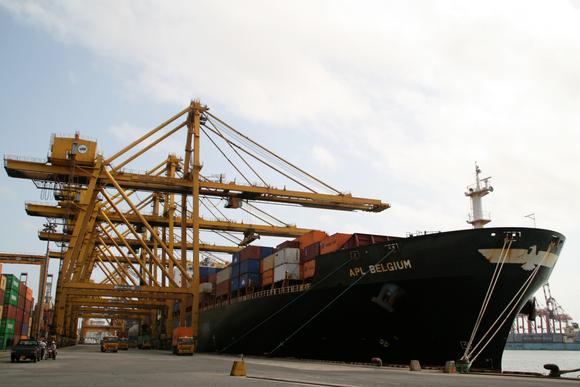![]()
Saturday, 16th August 2014
TAKAFUMI HOTTA, Nikkei staff writer

The Port of Colombo is undergoing a massive expansion project.
COLOMBO -- Sri Lanka is becoming a hot commodity among businesses looking to position themselves in the Pan-Indian Ocean economic zone.
The region consists of a number of emerging countries expected to become ever more populated. Some estimates put the region's combined population in 2040 at around 3 billion, which would be a third of the world's total.
Conveniently situated in the middle of this vast area, Sri Lanka has a vision of becoming a hub for people, money and goods that flow through the region's economies. As such, the island nation is attracting companies from China, India and elsewhere that want to tap a massive potential demand.
After ending a civil war in 2009, President Mahinda Rajapaksa shifted his attention to the development of ports and other infrastructure. The government has thrown its full weight behind the goal of becoming a pivotal crossroads of the economies around the Indian Ocean.
The expansion of port facilities in Colombo, Sri Lanka's biggest city, highlights just how ambitious the government's vision is.
A brand new cargo terminal was added to the port last August for $500 million. The new giant cranes lining this facility are only the beginning. Plans have already been made to add two more terminals at the port. Already, 5km of breakwaters have been completed.
Construction sites at the port are peppered with the Hyundai logo. South Korea's Hyundai E&C has been handling the groundwork, and terminals are being built by a consortium that includes China Merchant Holdings (International), a major port facility operator.
The port development plan calls for boosting its total container handling capacity 2.5-fold to 12 million TEUs (20-foot equivalent units). Meeting this goal would lift Colombo's ranking among the world's major container ports from 32nd to around 10th.
Logistically sound
Logistics firms around the world have been paying close attention to this development. Japan's SG Holdings is one of them.
The holding company of Sagawa Express, a parcel delivery group, acquired a major listed Sri Lankan logistics company in June through a Singaporean unit for roughly 8 billion yen ($77.2 million). The deal, which is one of the biggest acquisitions ever for the company, took two years to put together.
Purchasing Expolanka Holdings gives the Japanese group the Sri Lankan company's broad business bases in South Asia and Africa.
"We made the decision to build a foothold in this growing pan-Indian Ocean economic zone," said Yoshifumi Matsubara, director at SG Holdings Global. The Singaporean unit, which oversees the group's global operations, began to see encouraging sales reports by July.
The group received an order to handle shipments from an apparel maker in the southern Indian city of Chennai. It was also asked to provide a quote for shipping goods to Africa. These opportunities were rare prior to the Expolanka acquisition. The Japanese group's overseas operations have until recently been focused on Southeast Asia and China.
10 years ahead of India
India's population of 1.2 billion makes it the central player in any pan-Indian Ocean grouping. But Sri Lanka, with just 20 million people, is drawing attention for two advantages over the giant neighbor.
The first is its location. Ships crossing the Indian Ocean can complete the journey in a nearly straight-line passage and still make call in Sri Lanka.
"If the ship stops at Mumbai, it will take an extra day to go there and come back," a Sri Lankan port bureau official said.
The second reason is infrastructure. Although the civil war had been nearly the only thing reported about the country in recent years, Sri Lanka has actually made more progress in infrastructure development than India has.
Its towns are clean. More than 90% of homes are on power grids. And the literacy rate is over 90%, thanks to free public education. Many Indian people who visit Sri Lanka say it is 10 years ahead of their country in terms of infrastructure.
Window to world
Just as Hong Kong and Singapore rose on the back of the economic growth in China and Southeast Asia, Sri Lanka may be able to tap India's explosive economic potential and become an advanced economy that acts as key driver of the pan-Indian Ocean economic zone.
It seems the vision of turning Sri Lanka into such a regional hub already enjoys wide acceptance.
In an exclusive area of Colombo, Indian conglomerate ITC and Hong Kong-based Shangri-La are building hotels next to each other. Two rival luxury hotels being built simultaneously in one location is rare anywhere in the world.
"We definitely want to win orders for Shangri-La Hotel's 500 or so guest rooms," Keitaro Suma, president of Shin Nippon Lanka, said.
The local unit of Shin Nippon Air Technologies, a major Japanese air-conditioning company, won an order from a 500-room hotel project in July. More than 100 construction plans exist in Sri Lanka today for hotels alone.
Shin Nippon Air Technologies made a foray into Sri Lanka in 1980. The company has suffered some setbacks, but it has been on an uptrend in recent years, with sales doubling in the past two years.
"The construction boom will last for at least 10 more years," Suma said.
As more businesses wake up to the potential of Sri Lanka as a key regional hub, more investment and development projects are set to follow. This will likely attract even more foreign companies to come to the country for opportunities.
Nikkei staff writers Sadachika Watanabe in Jakarta and Atsushi Tomiyama in Tokyo contributed to this article.
From : http://asia.nikkei.com/Politics-Economy/Economy/Sri-Lanka-rides-high-on-region-s-growth-potential

